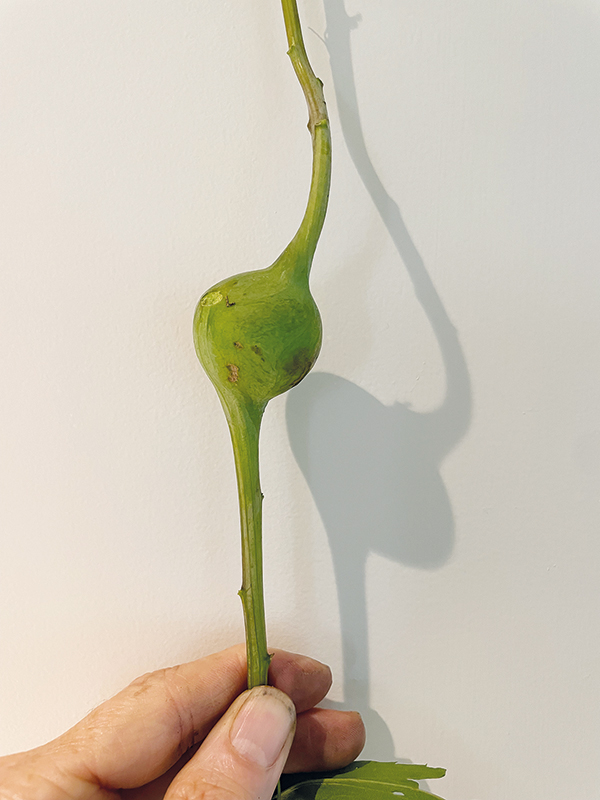Plant Intelligence

Un texte de Sarah Cobb
Paru dans le numéro Automne/Fall 2024
Publié le : 14 août 2024
Dernière mise à jour : 16 août 2024
Sarah Cobb introduces us to the inspiring world of plant intelligence and to the creative ways plants sense and adapt to their environment.
I am reading an amazing book called The Light Eaters and in it, author Zoë Schlanger talks about shifting away from a successful but depressing career reporting on our ever-worsening climate. Rather than being driven to despair, she opted to dig into the inspiring world of plant “intelligence” – to find solace in the creative ways plants sense and adapt to their environment.
The Dodder Vine
She describes a singular plant called the Dodder vine which emerges from the ground as a leafless stem which waves around until it finds a neighbour and latches on. It wraps itself around its neighbour several times, gluing itself to the stalk and then little spikes emerge from the coil and it sinks its “teeth” in. It then sheds its root system because it gets everything it needs to survive from its new host. Researchers recently discovered that the vine is surprisingly choosy about which plant it elects as its host. Given the choice between two equidistant neighbours, the vine will always grow toward the host that is juicier and healthier and more full of nutrients. The question is how? How does it know which neighbour is healthier before it even touches it?
The Marcgravia evenia
There is another vine called the Marcgravia evenia found only in Cuba that has developed a special leaf that hangs over every cluster of flowers which, in turn, hangs over little cups of nectar. The leaf is not the right shape for photosynthesis, but it turns out it is the right shape to reflect sonar, which it does. Perfectly. From every direction. Thanks to those leaves, the M. evenia is found twice as fast as any other flower by its pollinator, the Monophyllus bat. The bats sip the nectar and the flowers above hit their rumps with a blast of pollen, ensuring their future. Once pollinated, the little leaf lowers itself so it no longer returns the bat signal.
The Goldenrod
Closer to home, the lowly Goldenrod does an elaborate dance with gall-forming insects. You may have noticed, walking through the fields around town, plant stems that look like they’ve swallowed a marble or an egg. The female gall fly lays her eggs on the stalk and, once the larva hatch, they burrow into the stem. Something in the fly’s larva mimics plant hormones causing the goldenrod to form a gall (a ball) around the larva which ironically provides nutrition and a safe place for the larva to grow.
But the Goldenrods aren’t just sitting ducks in the field. Researchers have discovered that they are keenly attuned to the pheromones emitted by the male fly to attract his mate. Even a sniff of the pheromone causes the plant to boost levels of jasmonic acid (Goldenrod’s version of bug repellent). And other Goldenrods’ defense systems involve ducking, bending their heads down during mating season. The upside-down position of the stem confuses the bugs and they go elsewhere, after which the Goldenrod straightens right back up.
Not Just Passive Creatures
These are but a few examples of plants taking note of what’s around them and reacting – sometimes for their own safety and sometimes for the good of their kind. They demonstrate the ability to sense and respond, to evaluate and adjust, and all without a “brain”. Botanists theorize that because plants are immobile and often need to shed parts of themselves to protect the whole it made more sense for them to evolve a decentralized system for decision-making. After all, a brain in a branch that was withering away wouldn’t do the plant much good. The more scientists dig, the more they find evidence that plants are far more than just the passive oxygen producers we give them credit for.
I was walking on the mountain the other day, through the lush undergrowth of ferns on the Dos de l’Orignal. Long before dinosaurs walked the earth, ferns ruled this planet. Found on every single continent, fossils indicate they were giants that sometimes grew up to 100 feet tall. And it is largely thanks to them that our atmosphere holds enough oxygen for those of us who breathe it to evolve. Today, they are a fraction of their former size but can still be found almost everywhere, amid countless other plants, tucked into damp, shady places all over the world. ‘Are they sensing me as I walk by?’, I wondered, as I brushed my hand along their cool fronds. Are they thinking, “we used to rule this place but now we play just a small part in this incredible ecosystem”.
And it made me hopeful. Perhaps someday we will learn our place, too.
Sarah Cobb

